Nigel Tao
Mı~Le~Nıε~L: an English Phonetic Alphabet
Update on 2022-04-21: if your web browser doesn’t have all of the necessary fonts (so that some symbols below look like empty boxes), there’s a PDF version of this page that will look better.
Update on 2020-05-09: “phonetic alphabet” here is as in International Phonetic Alphabet (spelling words æz ðeɪ saʊnd), not as in NATO Phonetic Alphabet (Alfa, Bravo, Charlie, etc.).
COVID-19 has meant that I’m unexpectedly home-schooling my young child to read and write. In doing so, it’s pretty obvious that English spelling has much room for improvement. Wikipedia’s English-language spelling reform page opens with:
For centuries, there has been a movement to reform the spelling of English. It seeks to change English spelling so that it is more consistent, matches pronunciation better, and follows the alphabetic principle. Common motives for spelling reform include quicker, cheaper learning, thus making English more useful for international communication.
My motivation was less worldwide reform (it ain’t going to happen) and more an
intellectual exercise to keep my wandering mind engaged whilst reading
children’s literature out loud. I’ve designed an English phonetic alphabet
called Mı~Le~Nıε~L (or, in ordinary English, “Millennial”). An alternative
Romanization (see below) is miileeniol.
Trying to capture both American and British pronunciations (e.g. rhoticity), let alone a menagerie of regional dialects, with a single phonetic spelling is a lost cause. This document uses Received Pronounciation (RP), generally associated with the south of England.
Design
Many others have tried this before. To sample just a few, the International Phonetic Alphabet (IPA) is the most famous system, but by being universal (not just English) and precise (able to discriminate American and British English), it’s also complicated, with over 100 letters and 50 diacritics. Deseret and Shavian are more focused, but to somebody who already and only knows English spelling, they look alien. You need to explicitly learn the system before being able to even guess how to read this or that. There are many other designs, each with their own trade-offs.
Mı~Le~Nıε~L re-uses most of the English alphabet, borrowing a little more
from the Greek and Cyrillic alphabets to complete a set of 30 letters (24
consonants and 6 base
vowels) and 2 diacritics (used only for
vowels). Every English consonant and vowel has a unique Mı~Le~Nıε~L letter
(or letter and diacritic). Only
diphthongs are
digraphs.
Today, billions of people already read English and millions of people already
read Greek and Cyrillic, so Mı~Le~Nıε~L uses Γ and Ж for the “ng” and
“zh” sounds instead of IPA’s “ŋ” and “ʒ”. Using a Greek delta “Δ” or theta “Θ”
may not be as faithful as using the Old English eth “ð” or thorn “þ”, but the
trade-off is greater familiarity for many. The Mı~Le~Nıε~L vowel ε~, a
schwa, is more like the IPA “ə” than the IPA “ε”, but “ə” is not part of the
Latin, Greek or Cyrillic alphabets.
A key design goal is that many people who already know English should be able
to read Mı~Le~Nıε~L (perhaps slowly, with a bit of guesswork) without having
to study beforehand.
That’s partly because consonants are always tall (cap height) and vowels are always short (x height), so it’s possible to focus only on the consonants, most of which are the same as in English. Ppl cn ftn stll rd nglsh txt whn th vwls r rmvd. See also: Abjads.
Here are a couple of sample Mı~Le~Nıε~L texts. There are more further below.
Those of you who enjoy word puzzles might like to cover up the right hand side
(the red English text) and try to read the left hand side (the equivalent blue
Mı~Le~Nıε~L text). Remember that pronunciation is (non-rhotic, southern)
“British”, where some “r” sounds are dropped (from an “American” perspective).
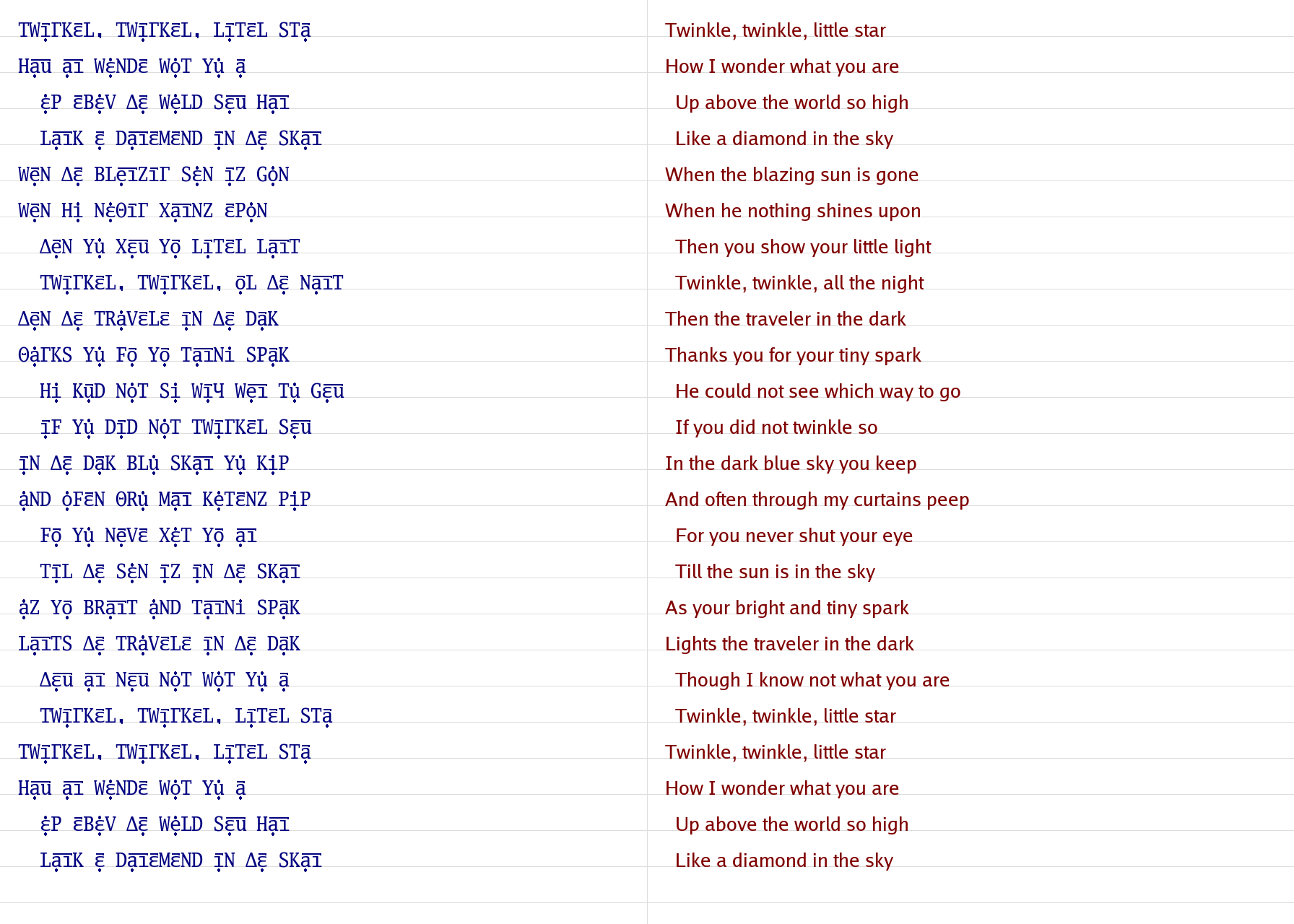

44 Phonemes
There are 24 consonants. There are 12 vowels, combining a base vowel (there are
6) and a diacritic mark (a dot or
vertical stroke ' or a horizontal line ~) over the base. There are 8
diphthongs, which always combine two overlined vowels and the line literally
joins the two letters as a
ligature. An implication
is that two adjacent vowels that don’t share an overline form separate
syllables. For an example, see “created” in the Lincoln text (the second
example above). An optional underdot denotes a stressed syllable.
In the following tables:
- The first column (“Mı~”) is the canonical
Mı~Le~Nıε~Lspelling. The diacritics look better above the vowels (as in the sample images) than alongside the vowels (as in this document’s text), but for technical reasons, the textual form can’t assume that appropriate fonts are available. - The second column (“Rom”) shows a secondary transliteration system that’s
restricted to the 26 letters of the English alphabet. Digraphs are used for
some consonants, every vowel and every diphthong. For example,
Mı~Le~Nıε~Lcan be Romanized as “miileeniol”. - The third column (“IPA”) is the International Phonetic Alphabet equivalent.
- The fourth column gives examples of complete words.
24 Consonants
Mı~ Rom IPA Examples (Mı~Le~Nıε~L = English)
------------------------------------------------------------
P p p Pa'D = pad Ha'Pı' = happy
B b b Ba'D = bad Beı~Bı' = baby
T t t Taı~T = tight Mεu~T = moat
D d d Daı~D = died Mεu~D = mode
K k k Ba'K = back No'KT = knocked
G g g Ba'G = bag Ga'Γ = gang
Ч tx tʃ Bı'Ч = beach Чe'Ч = church
J j dʒ Ba'J = badge Joı~ = joy
F f f Fa'T = fat Rε'F = rough
V v v Va'T = vat He~Vı' = heavy
Θ th θ θı'M = theme Tı'Θ = teeth
Δ dh ð Δe~M = them Tı'Δ = teethe
S s s Bε'S = bus Saı~Ze'Z = sizes
Z z z Bε'Z = buzz Zı~PS = zips
X x ʃ Ba'X = bash Mı~Xε~N = mission
Ж zh ʒ PLe~Жε~ = pleasure Vı~Жε~N = vision
M m m Bε'M = bum Ma'Mε~L = mammal
N n n Bε'N = bun Na'Nı' = nanny
Γ ng ŋ Ba'ΓK = bank Dı~Γı' = dinghy
H h h Ho'T = hot Mı~SHa'P = mishap
L l l Lo'T = lot Fo'Lı' = folly
R r ɹ Ro'T = rot So'Rı' = sorry
Y y j Ye~S = yes BYu'Tı' = beauty
W w w We~B = web SKWeε~ = square
------------------------------------------------------------
12 Vowels
Mı~ Rom IPA Examples (Mı~Le~Nıε~L = English)
------------------------------------------------------------
ı' ia i,iː Bı'T = beat Sı'D = seed
ı~ ii ɪ Bı~T = bit Kı~T = kit
u' ue u,uː Bu'T = boot Lu'P = loop
u~ uu ʊ Bu~K = book Pu~T = put
e' ea ɜː Be'N = burn STe' = stir
e~ ee e,ɛ Be~T = bet Me~S = mess
ε' ua ɐ,ʌ Bε'T = but Mε'D = mud
ε~ oo ə,ɚ Bı'Vε~ = beaver ε~Lau~ = allow
a' ae æ Ba'T = bat Ta'P = tap
a~ aa ɑː Ba~N = barn Ta~T = tart
o' oe ɒ Bo'T = bot Fo'G = fog
o~ oa ɔː Bo~L = ball No~Θ = north
------------------------------------------------------------
8 Diphthongs
Mı~ Rom IPA Examples (Mı~Le~Nıε~L = English)
------------------------------------------------------------
ıε~ io ɪə Bıε~ = beer Nıε~ = near
uε~ uo ʊə KYuε~ = cure Tuε~ = tour
eı~ ei eɪ Beı~T = bait Feı~S = face
eε~ eo eə,ɛə Beε~ = bear eε~ = air
εu~ ou əʊ,oʊ Bεu~T = boat Xεu~ = show
aı~ ai aɪ Baı~T = bite Haı~ = high
au~ au aʊ Bau~T = bout Nau~ = now
oı~ oi ɔɪ Boı~ = boy Soı~L = soil
------------------------------------------------------------
Vowel Diphthong Grids
Vowels can be arranged like the IPA vowel chart.
: Front Central Back
: Close +------------------+------------------+
: \ ı' \ u' |
: \ ı~ \ u~ |
: \ \ |
: Close-mid +--------------+--------------+
: \ \ |
: \ e~ \ ε~ ε' |
: \ e' \ o' |
: Open-mid +----------+----------+
: \ \ |
: \ a' \ a~ |
: \ \ o~ |
: Open +------+------+
Vowels and diphthongs can alternatively be arranged by their 2-letter Romanization.
?a ?e ?i ?o ?u
+----------+----------+-----------+--------------+----------+
| a~ Ba~N | a' Ba'T | aı~ Haı~ | | au~ Nau~ |
a? | barn | bat | high | | now |
| ɑː bɑːn | æ bæt | aɪ haɪ | | aʊ naʊ |
+----------+----------+-----------+--------------+----------+
| e' Be'n | e~ Be~T | eı~ Feı~S | eε~ eε~ | |
e? | burn | bet | face | air | |
| ɜː bɜːn | ɛ bɛt | eɪ feɪs | ɛə ɛə(ɹ) | |
+----------+----------+-----------+--------------+----------+
| ı' Bı'T | | ı~ Bı~T | ıε~ Nıε~ | |
i? | beat | | bit | near | |
| iː biːt | | ɪ bɪt | ɪə nɪə(ɹ) | |
+----------+----------+-----------+--------------+----------+
| o~ Bo~L | o' Bo'T | oı~ Soı~L | ε~ Bı'Vε~ | εu~ Xεu~ |
o? | ball | bot | soil | beaver | show |
| ɔː bɔːl | ɒ bɒt | ɔɪ sɔɪl | ə biːvə(ɹ) | əʊ ʃəʊ |
+----------+----------+-----------+--------------+----------+
| ε' Bε'T | u' Bu'T | | uε~ Tuε~ | u~ Bu~K |
u? | but | boot | | tour | book |
| ʌ bʌt | uː buːt | | ʊə tʊə(ɹ) | ʊ bʊk |
+----------+----------+-----------+--------------+----------+
More Examples
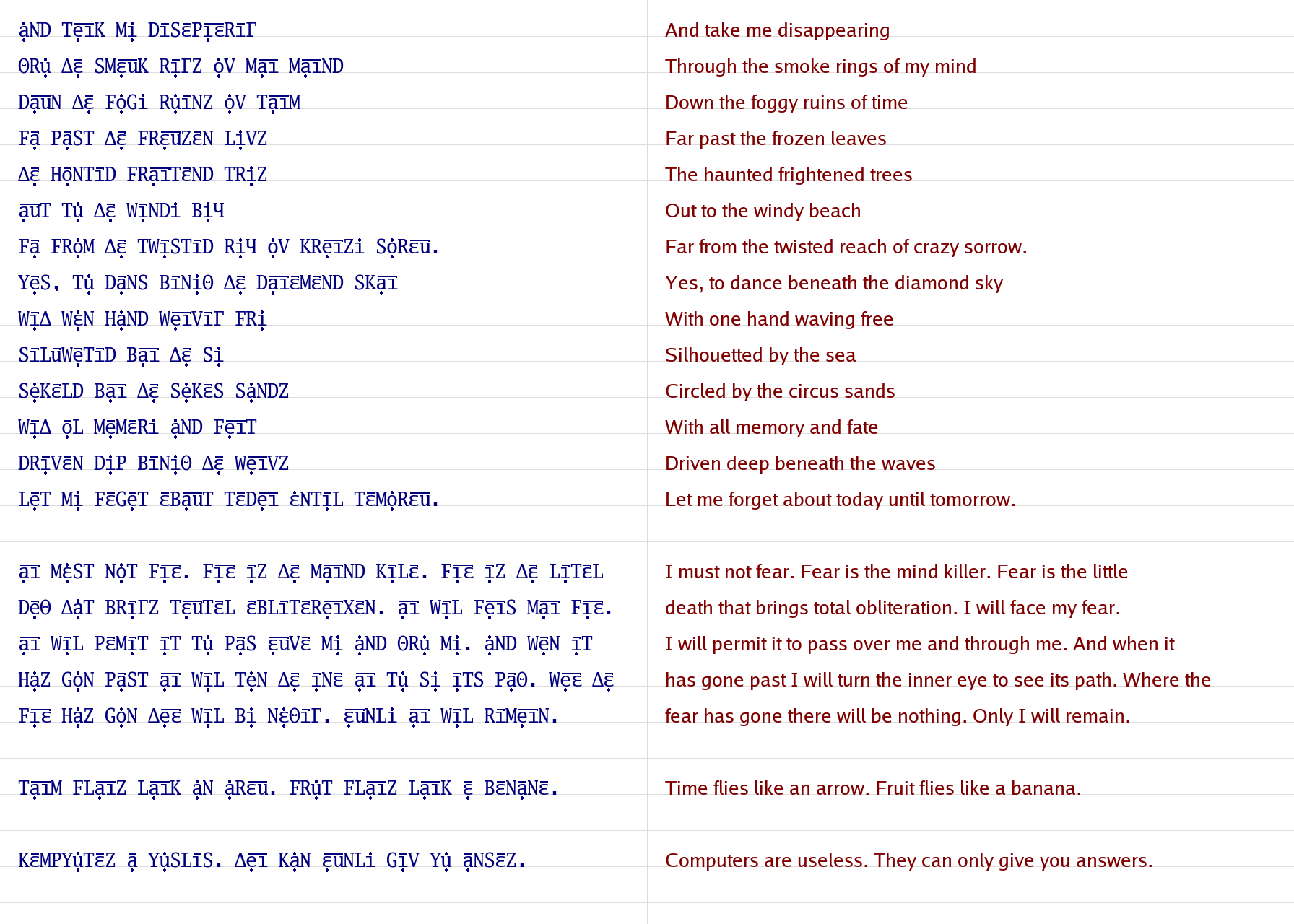



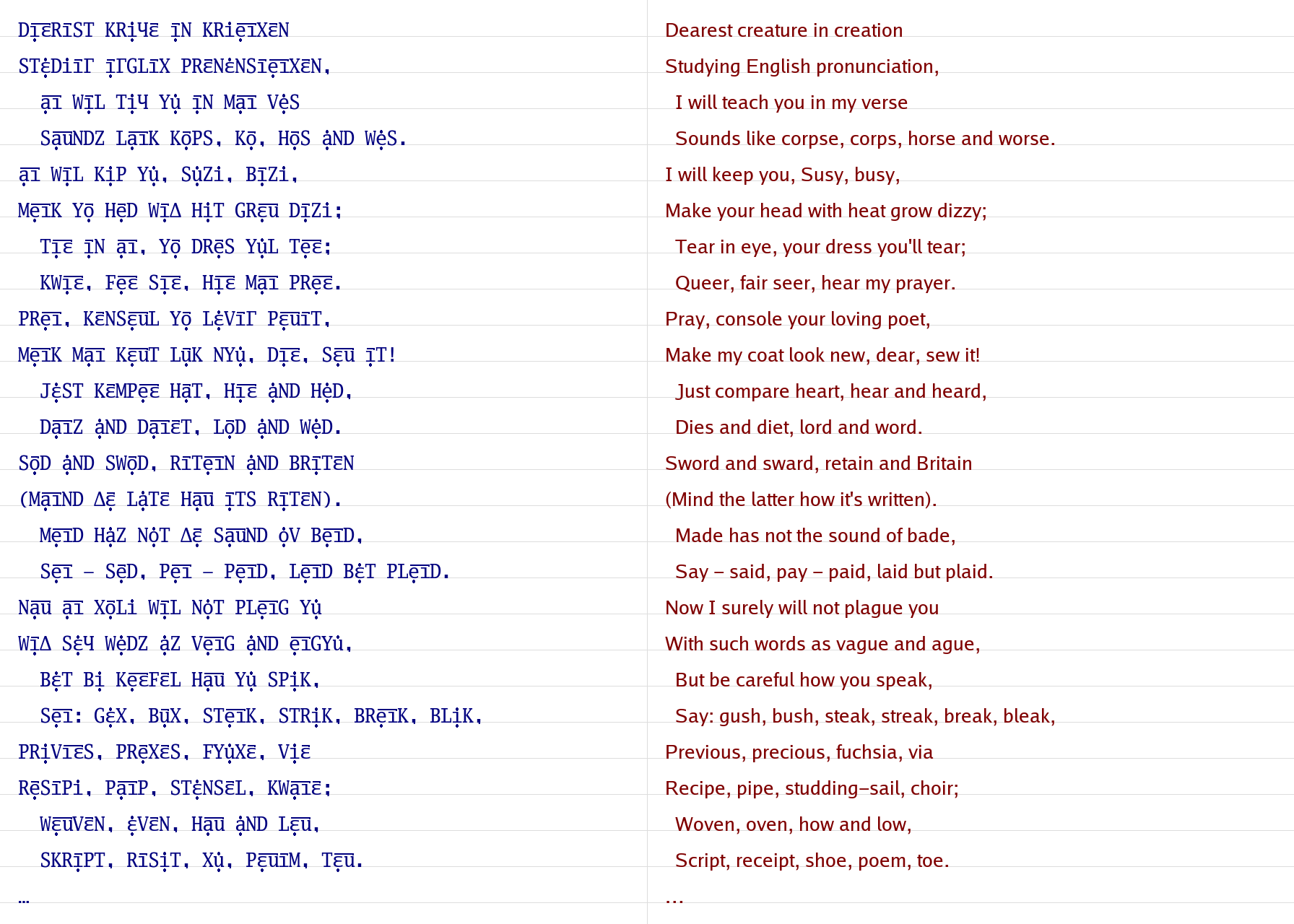
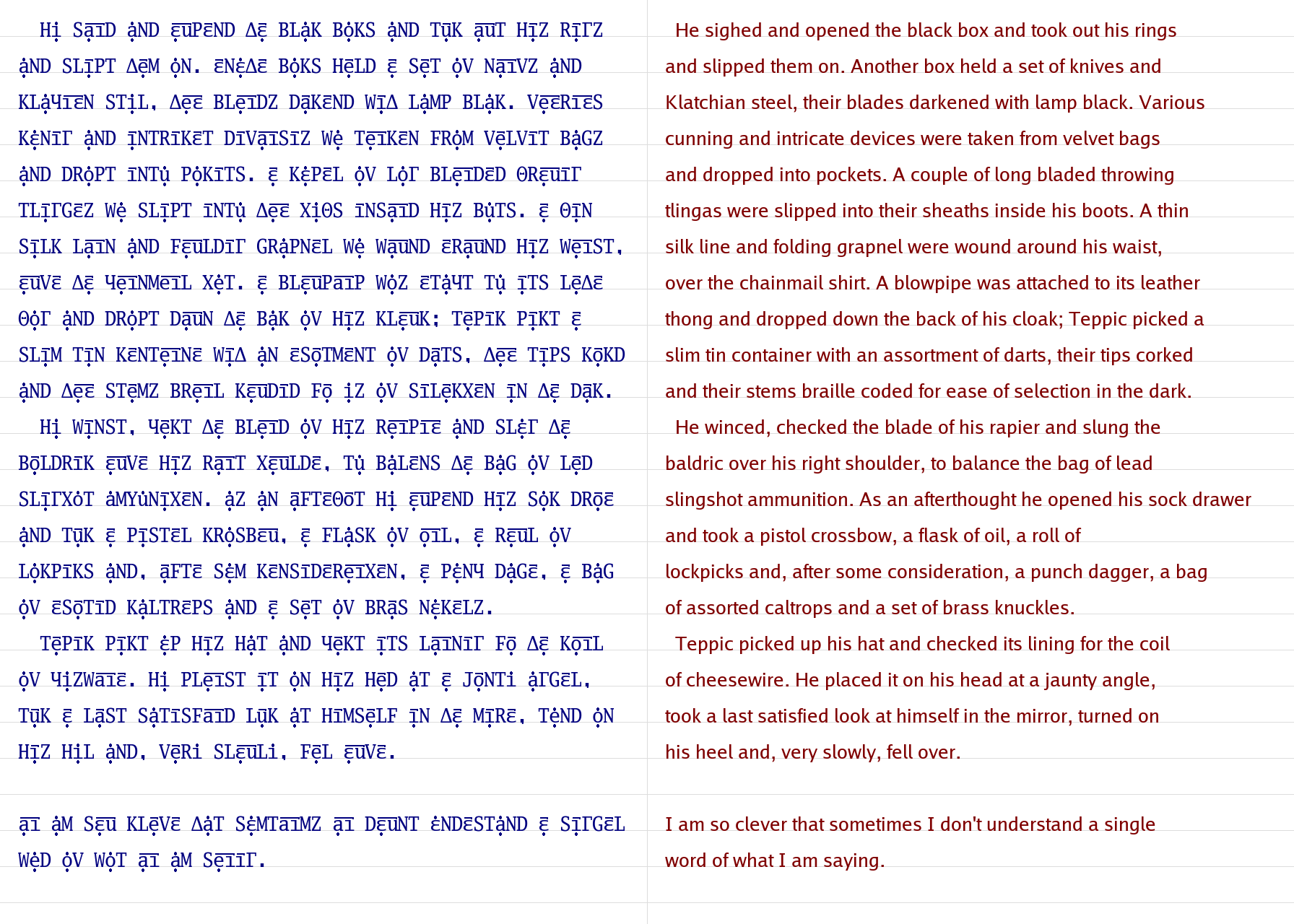
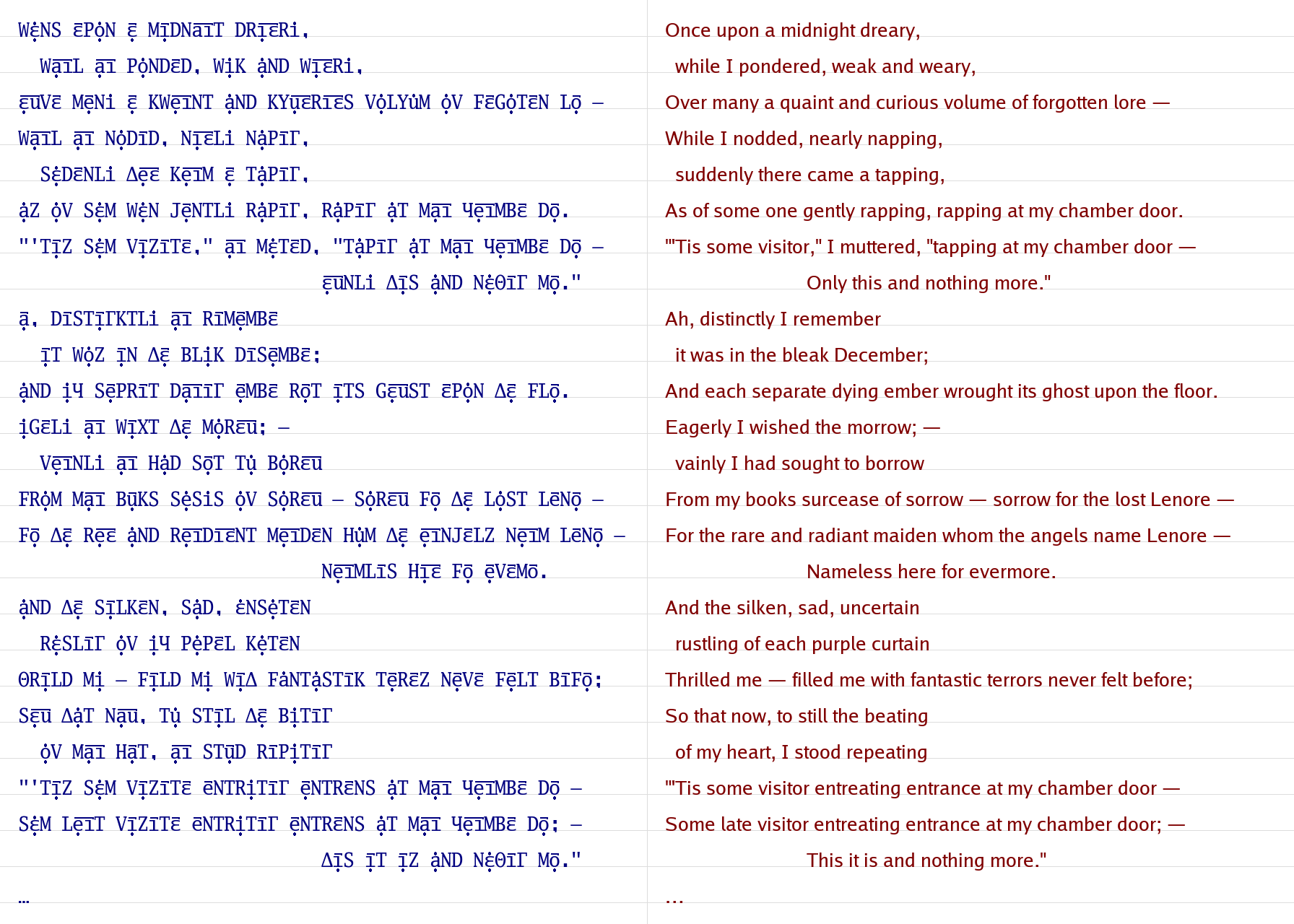
Romanization Examples
twiingkool twiingkool liitool staa
hau ai wuandoo woet yue aa
uap oobuav dhoo weald seu hai
laik oo daioomoond iin dhoo skai
foa skoa aend seevoon yiez oogeu auoo faadhooz broat foath oen dhiis
koentiinoont oo nyue neixoon koonsiavd iin liibootia aend
deediikeitiid tue dhoo proepooziixoon dhaet oal meen aa kriaeitiid iakwool
Admittedly, this is reminiscent of iorz feixfuli, which isn’t flattering.
Software
There’s not really a software product associated with all of this, but I’ve uploaded to Github the small program used to mash the Go Mono font with the Britfone pronouncing dictionary to generate the images above.
Further Reading
If you found this interesting, you might also enjoy these Wikipedia pages:
- ARPABET
- Canadian Aboriginal syllabics
- Cot-caught merger
- Dakuten and handakuten
- English orthography
- English phonology
- English-language spelling reform
- Māori language
- Hangul
- Initial Teaching Alphabet
- International Phonetic Alphabet
- Pronunciation respelling for English
- Romic alphabet
- Tengwar
- Unifon
- Vowel shift
Published: 2020-05-08